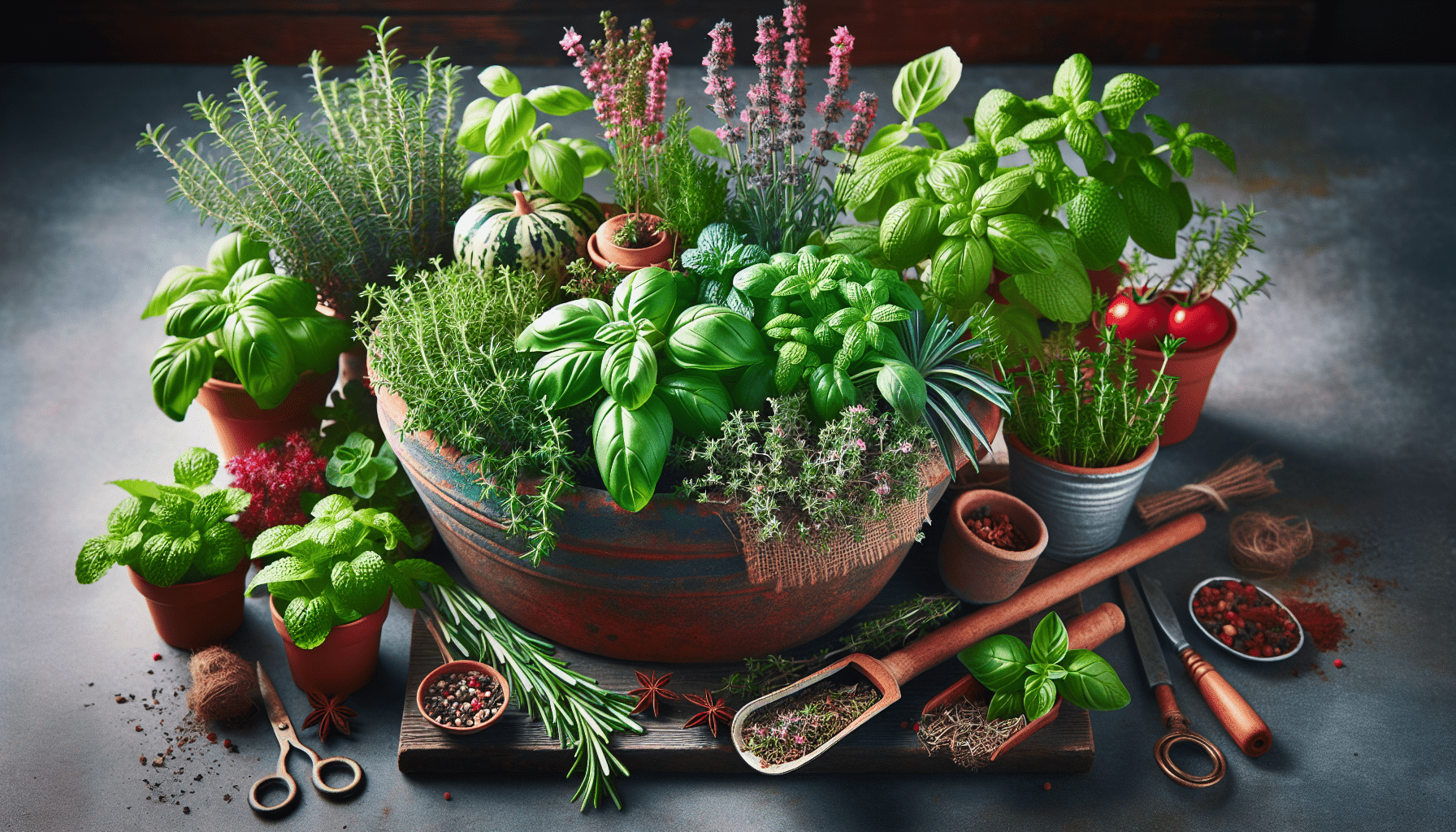So, you’ve decided to embark on the journey of creating your very own herb garden. Fantastic choice! Not only will it add beauty and fragrance to your home, but it will also provide you with fresh and flavorful herbs for your culinary creations. Whether you have a spacious backyard or just a tiny balcony, this article will guide you through the process of planning and creating a stunning herb garden in planters. Get ready to infuse your dishes with the taste of nature!
Selecting the Right Location
When choosing a location for your herb garden, there are a few important factors to consider. First, evaluate the sunlight exposure in the area. Most herbs thrive in full sun, so make sure the spot you choose gets at least six hours of direct sunlight each day. If your options are limited and you have a shady yard, you can still grow herbs that tolerate partial shade, such as mint or parsley.
Next, check the soil drainage in the chosen location. Herbs generally prefer well-draining soil to prevent waterlogged roots, which can cause root rot. If your soil tends to be heavy and holds water, consider raised beds or containers to provide better drainage.
Lastly, consider the proximity of your herb garden to the kitchen. It’s much more convenient to have your herbs close to your cooking area, so you can easily grab fresh sprigs or snip leaves while you’re preparing meals. This way, you’ll be more likely to use your herbs on a regular basis and fully enjoy the flavors they add to your dishes.
Choosing the Best Herbs
When it comes to selecting the best herbs to grow in your garden, there are a few key factors to consider. First, research different types of herbs to determine which ones you’re most interested in and that suit your culinary preferences. Popular choices for herb gardens include basil, rosemary, thyme, oregano, and mint. Each herb has its own unique flavor and uses in cooking, so choose the ones that align with your taste preferences.
Consider your climate when selecting herbs for your garden. Some herbs are more cold-hardy, while others thrive in warmer climates. Take into account the temperature ranges and frost dates in your area to ensure you choose herbs that will thrive in your specific environment.
Lastly, think about the culinary uses of the herbs you’re considering. If you love Italian cuisine, for example, you’ll want to have a variety of Mediterranean herbs like basil, oregano, and thyme. If you enjoy making herbal teas or infused oils, consider growing herbs like chamomile, lavender, or lemon balm. Tailoring your herb selection to your culinary preferences will ensure that you have a garden that provides the fresh flavors you love.
Designing the Layout
Before you start planting, it’s important to have a clear plan for the layout of your herb garden. First, decide on the size of your garden. Consider how much space you have available and how many herbs you want to grow. Keep in mind that herbs can often be planted closer together than other plants, as they don’t require as much space to flourish.
Creating a sketch or plan can help you visualize your garden and ensure that you make the most of the space you have. Include the location of each herb, taking into account their size and growth habits. This will help you determine the best placement for companion planting, where certain herbs benefit from being grown together.
Speaking of companion planting, consider this practice when designing your herb garden. Companion planting involves growing certain plants together to enhance growth, deter pests, or improve flavor. For example, planting basil near tomatoes can improve the flavor of the tomatoes while deterring pests. Do some research on companion planting and choose herbs that complement each other to create a harmonious and beneficial garden.
Preparing the Soil
Properly preparing the soil is essential for the success of your herb garden. First, remove any weeds and grass from the area where you want to plant your herbs. Weeds compete with herbs for nutrients and water, so it’s important to ensure they’re completely cleared out.
Next, loosen the soil to create a better environment for herb roots to penetrate and grow. Use a garden fork or tiller to gently break up the soil, especially if it’s compacted. This will also help improve the drainage of the soil, preventing waterlogged conditions that can harm your herbs.
To further improve the soil quality, consider adding compost or organic matter. This will enrich the soil with nutrients and help retain moisture, creating a fertile environment for your herbs to thrive. Mix the compost into the top few inches of soil to ensure it’s well-distributed.
Planting the Herbs
Once your soil is prepared, it’s time to plant your herbs. You have the option to start seeds indoors or purchase seedlings from a nursery or garden center. Starting seeds indoors allows for earlier planting and gives you more variety to choose from, while purchasing seedlings provides a head start and simplifies the process.
Regardless of whether you start from seed or use seedlings, make sure to follow the recommended spacing and planting depth for each herb. Crowding can restrict the growth of your herbs, so be mindful of the recommended spacing provided on seed packets or nursery tags. Planting at the correct depth will encourage proper root development and ensure your herbs establish themselves well.
Water your herbs immediately after planting to help settle the soil and provide them with the moisture they need to start growing. Give them a thorough watering and continue to water regularly, keeping the soil consistently moist but not soggy.
Providing Proper Care
Proper care is essential for the health and vitality of your herb garden. One of the most important aspects of care is regular watering. Herbs generally prefer evenly moist soil, so keep an eye on the moisture levels and water whenever the top inch of soil feels dry to the touch. Avoid overwatering, as this can lead to root rot and other issues.
Mulching around your herbs is a great way to conserve moisture and suppress weed growth. Apply a layer of organic mulch, such as straw or wood chips, around the base of your plants. This will help retain moisture in the soil and reduce the need for frequent watering. Additionally, mulch acts as an insulator, protecting the roots from extreme temperature fluctuations.
While herbs don’t typically require heavy fertilization, it’s important to monitor their nutrient needs. If you notice signs of nutrient deficiencies, such as yellowing leaves or poor growth, consider fertilizing your herbs. Use a balanced organic fertilizer or compost tea to provide a gentle boost of nutrients without overstimulating growth.
Managing Pests and Diseases
Unfortunately, herb gardens are not immune to pests and diseases. To effectively manage these issues, it’s important to identify common garden pests that may target your herbs. Learn to recognize pests like aphids, slugs, and caterpillars, as well as the damage they can cause. This will help you take prompt action if you notice any signs of infestation.
To prevent and control pests naturally, implement organic pest control methods. For example, you can introduce beneficial insects like ladybugs or lacewings that feed on common herb pests. You can also use natural pest repellents, such as neem oil or garlic spray, to deter pests from your plants.
In addition to pests, keep an eye out for signs of diseases in your herb garden. Common herb diseases include powdery mildew and fungal infections. Regularly inspect your plants for any discoloration, wilting, or unusual growth patterns. If you notice any signs of disease, promptly remove and dispose of affected plant parts to prevent further spreading.
Harvesting and Pruning
The joy of having an herb garden is being able to harvest fresh herbs for your culinary creations. Learning when to harvest each herb is essential to ensure you get the best flavor and quality. Generally, herbs are ready to harvest when they have reached a certain maturity, but it’s always a good idea to consult a gardening guide or reference for specific instructions on each herb.
When harvesting, use proper techniques to avoid damaging the plants. Snip or cut the herbs just above a pair of healthy leaves or nodes, as this will promote healthy regrowth. Avoid removing more than one-third of the plant at a time, as this can stress the herb and hinder its overall growth.
Regular pruning is also important to maintain the health and shape of your herb plants. By pinching back or trimming your herbs throughout the growing season, you encourage bushier growth and prevent legginess. Pruning also helps manage the size of the plants and prevents overcrowding in your garden.
Preserving Herbs for Future Use
If you find yourself with an abundance of fresh herbs, don’t let them go to waste. There are several methods for preserving herbs so that you can enjoy them throughout the year. Drying herbs is a popular method and can be done by tying bunches of herbs upside down in a well-ventilated area. Once completely dry, store them in airtight containers away from direct sunlight.
Another way to preserve herbs is by freezing them. Simply chop the herbs or leave them as whole leaves and place them in ice cube trays. Fill the trays with water or oil and freeze them. Once frozen, transfer the herb cubes to resealable bags for easy storage. These herb cubes can be dropped directly into soups, stews, or sauces for added flavor.
For a more gourmet approach, consider making herb-infused oils and vinegars. Place clean, dry herbs in a jar and cover them with olive oil or vinegar. Let the mixture steep for a few weeks to infuse the flavors, then strain out the herbs and transfer the infused oil or vinegar to a clean bottle. These make fantastic dressings or marinades and can be a lovely gift for herb-loving friends.
Enjoying Your Herb Garden
Once you have successfully grown and maintained your herb garden, it’s time to reap the rewards. Experiment with new recipes that incorporate the fresh flavors of your homegrown herbs. From pesto sauces to herbal teas, the possibilities are endless.
Hosting herb-themed gatherings can be a fun way to showcase your garden and share your love for herbs with others. Plan a garden party where guests can sample different dishes and drinks made with the herbs from your garden. You could even have a DIY herb bouquet station where guests can create their own herbal arrangements to take home.
Finally, don’t forget to share surplus herbs with friends and neighbors. Not only does this foster community and generosity, but it also ensures that none of your precious herbs go to waste. Consider making herb bouquets or small herb bundles as thoughtful gifts to brighten someone’s day.
With the right location, carefully chosen herbs, a well-designed layout, and proper care, you can create a beautiful and thriving herb garden. Whether you’re an experienced gardener or a novice, the joy and satisfaction of growing your own herbs are within your reach. So get started, and soon enough, you’ll be savoring the fresh flavors and fragrances of your very own herb garden.

